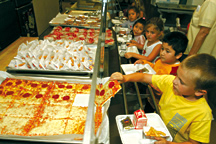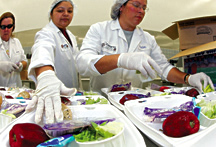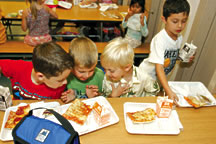EAT, DRINK & PLAY - ENTERTAINMENT
What's for Lunch?
September, 2005 - Issue #11
 Five-year old Noah Dent (yellow shirt) grabs a slice of pizza during the last week of school at Peachland Elementary. His classmate Roberto Solano ponders his lunch choices. |
The number of overweight and obese children and adolescents has doubled since 1980. Fast food and lack of physical activity are the top two culprits of this national epidemic and health experts have grave concerns.
"I see more overweight children every year," said Dr. Lorraine Stern of Valencia Pediatrics. "Who eat vegetables at a fast food restaurant?"
With the children now in school, the lunchtime favorite still seems to be mom's PBJ or tuna sandwiches, but there a thousands of children who line up everyday in school cafeterias. Countless jokes have been made about cafeteria food, enough to make a parent wonder: What's cooking?
Naomi Green said her daughter Rachel prefers to take a sack lunch to school. Rachel, a student at Peachland Elementary, enjoys the sandwich and healthy cookie snacks her mom provides. Green said she is concerned young children do not get enough exercise during the school day and acknowledges it's hard to find good food that is appealing to youngsters.
"There can be improvements (in the cafeteria food)," Green said. "Kids like certain foods and it's hard to think of healthy things they will eat."
Pavel Matustik, chief administrative officer of the Santa Clarita Valley Food Services Agency, has heard the complaints. The Agency has been providing breakfast and lunch for all the elementary school districts in the valley since the mid-'80s. Serving more than 20,000 meals on a daily basis that is both nutritional and appealing is a challenge, Matustik said.
The Agency has gone through many changes since its inception and Matustik is focused on educating the parents and students on the new and improved food choices.
"I think we are moving in the right direction," Matustik said. "There are no bad foods, but we need to teach everything in moderation."
 Food Services staff prepare meals for summer school students. Production begins at 6:30 a.m. and is delivered to individual school sites in time for lunch. |
Currently, less than one-half of the school population eats in the cafeteria. Matustik believes parents remember the scary and greasy meals of meatloaf and sloppy Joes from their own school day experiences. He hopes to change that image.
In the early stages, the Agency's central kitchen consistently ran in the red. Many in the community were outraged that funds used on the kitchen were being taken from the classroom. A controversial "red cart," selling items high in fat such as chips and churros, eventually turned the profit margin around, but parents again expressed their disapproval when it was said children were using lunch money to buy junk food.
Armed with input from parent organizations and new nutritional standards, the Agency began making changes. Out were the sugary snacks and colas and in came salad bars and juice drinks. An example of a recent menu included a Teriyaki burger, chicken nuggets, hamburger, pizza sticks or deli sandwich. The salad bar and a potato dish are provided everyday. The students must take at least one entree and one other item along with non-or low-fat milk. A lunch costs $2.25 and breakfast is $1.50 with items such as pancakes and breakfast burritos.
"We like it when they take everything," said SCVSF Director Anne Grandjean. "That's the way they get a well-balanced, nutritious meal."
Fifteen percent of the meals served are free or offered at a reduced price for disadvantaged children. Matustik believes that this is the only social program that truly works and having a good breakfast and lunch goes hand-in-hand with learning.
Over the years, Grandjean has initiated several innovative programs. She came to realize that many children didn't understand the basic concepts of cooking and launched a kids' cooking program. Six times a year, students from various school sites come to the central kitchen to plan and prepare a meal. They are taught nutritional content and learn how to hold a knife properly to chop vegetables. Tables are set and parents and school administrators are invited to lunch with the students. The kids love to cook, Grandjean said, and the program is a huge success.
"Children were loosing all the socializing that takes place during the preparation time which is important," she said. "I no longer go with (menu items) I like and go with what the students have tested," Grandjean said.
 Kindergarten students Devin Manjarrez, Sam Riddle, Jackson Bourne and Tyler Goeckeritz spend their lunchtime laughing and checking out each other's food. Pizza is the definite favorite of the little guys! |
Finding good nutritional menus and working with the students has been rewarding for Grandjean. "This is the best job I've ever had," she added.
A concern for the food services agency, but one they cannot change, is the amount of time given to students for lunch. With up to four lunch periods a day, schools scramble to find room to feed the students.
"If I could wave a magic wand, (I would give children) 20 minutes minimum to eat," Matustik said. "Food does not digest (in the time allowed)."
He would also like to encourage more parents to come to the school and eat lunch with their children. So far, not many have taken him up on that offer.
"The most important thing to do is educate the parents," Matustik said. "When we come to the PTA or other parent organizations and they see the changes we've made, their whole attitude changes."
These changes also need to be made in the home, Dr. Stern said, and she agrees getting children involved in the family meal planning is a good way to help them understand the importance of fruit and vegetables in their diet.
"Make sure they choose from each food group," Stern advises. "And make sure the television is off during the family meal."
--------------------------------------------------------------
For more information about nutritional guidelines or to see what is being served for lunch at your child's school, log on to the Agency website at www.scvsfsa.org.
|
||||||||||||||||||||||||||||





